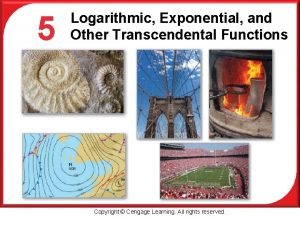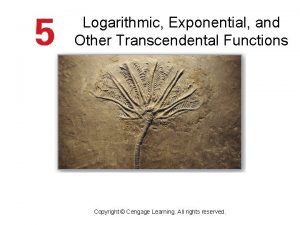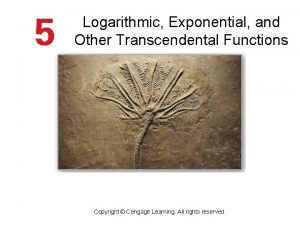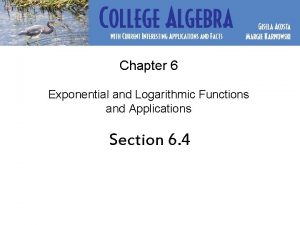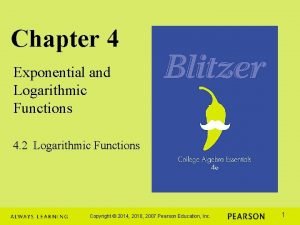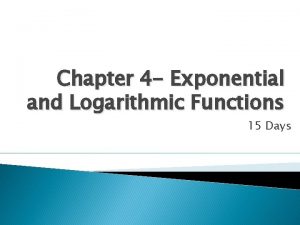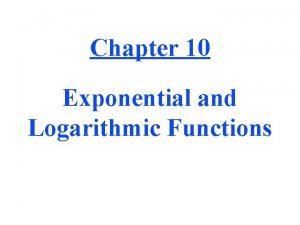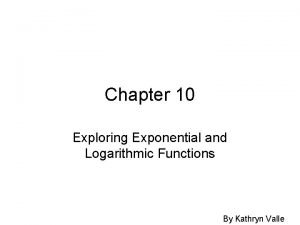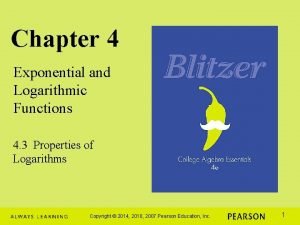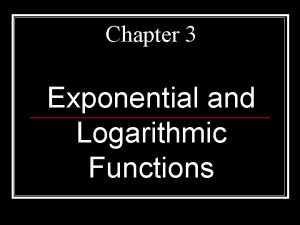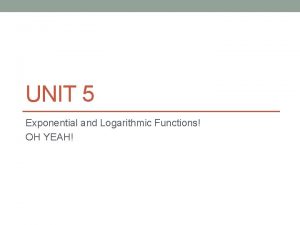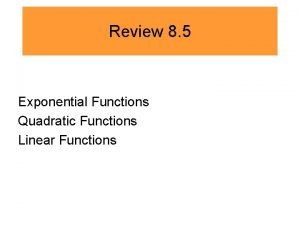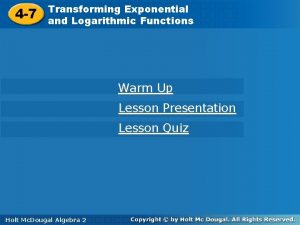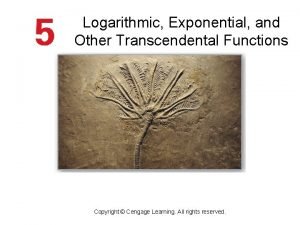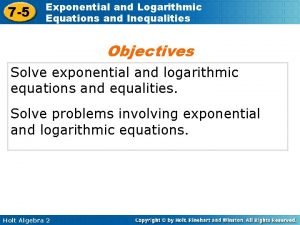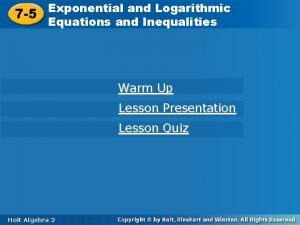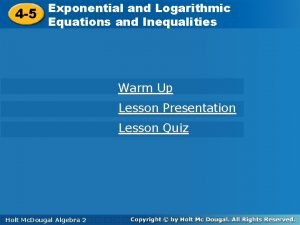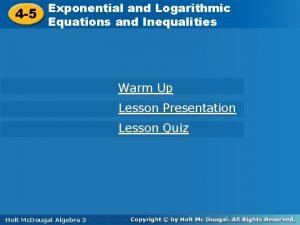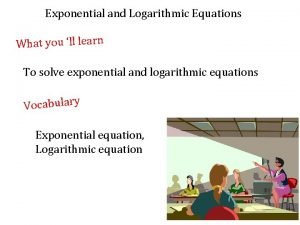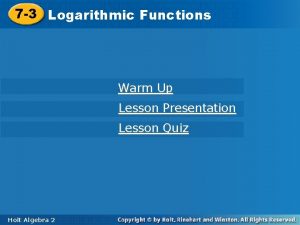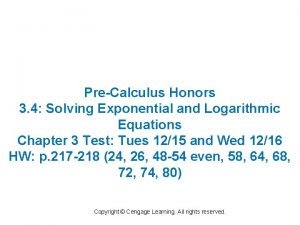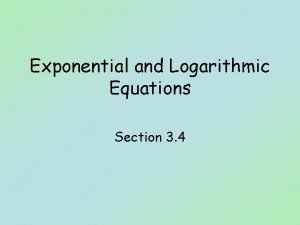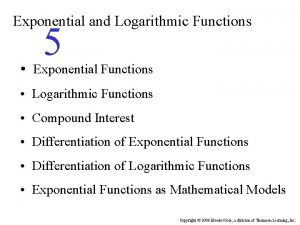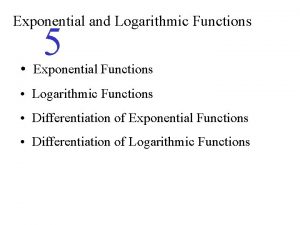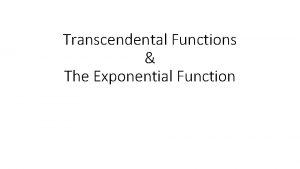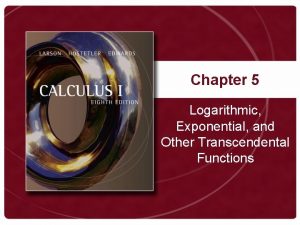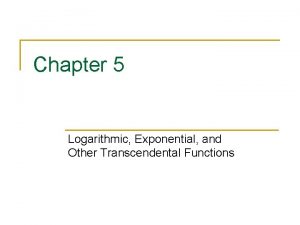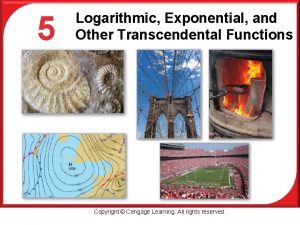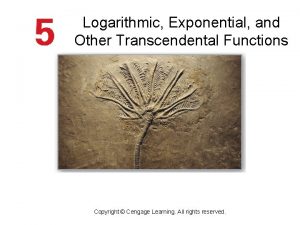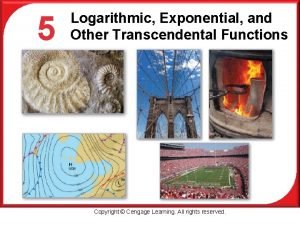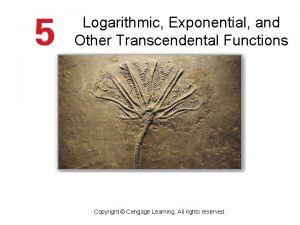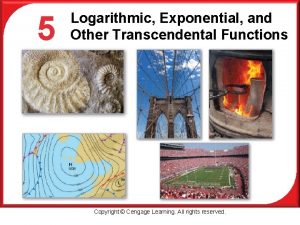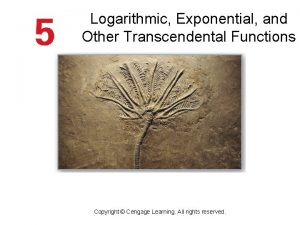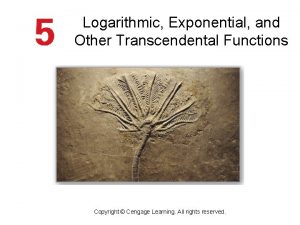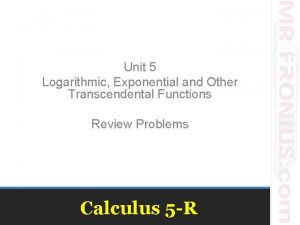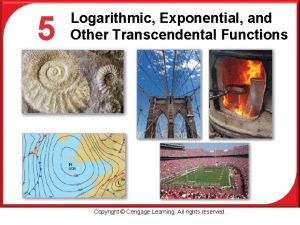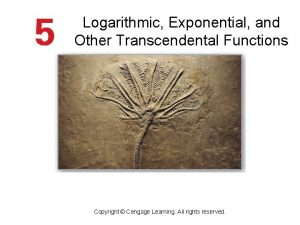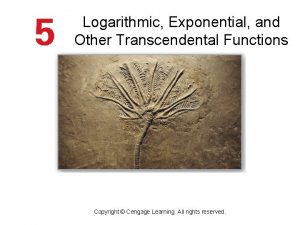Chapter 5 Logarithmic Exponential and Other Transcendental Functions

































- Slides: 33

Chapter 5 Logarithmic, Exponential, and Other Transcendental Functions

For x 0 and 0 a 1, y = loga x if and only if x = a y. The function given by f (x) = loga x is called the logarithmic function with base a. Every logarithmic equation has an equivalent exponential form: y = loga x is equivalent to x = a y A logarithm is an exponent! A logarithmic function is the inverse function of an exponential function. Exponential function: y = ax Logarithmic function: y = logax is equivalent to x = ay

y The function defined by f(x) = loge x = ln x (x 0, e 2. 718281 ) is called the natural logarithm function. y = ln x 5 – 5 y = ln x is equivalent to e y = x In Calculus, we work almost exclusively with natural logarithms! x

Definition of the Natural Logarithmic Function

Theorem 5. 1 Properties of the Natural Logarithmic Function

Natural Log

Natural Log Passes through (1, 0) and (e, 1). You can’t take the log of zero or a negative. (Same graph 1 unit right)

Theorem 5. 2 Logarithmic Properties

Properties of Natural Log: Expand: Write as a single log:

Properties of Natural Log: Expand: Write as a single log:

Definition of e

Theorem 5. 3 Derivative of the Natural Logarithmic Function

Derivative of Logarithmic Functions The derivative is Notice that the derivative of expressions such as ln|f(x)| has no logarithm in the answer. Example: Solution:

Example

Example

Example Product Rule

Example

Example

Example

Example

Theorem:

Theorem:



Theorem 5. 4 Derivative Involving Absolute Value


Try Logarithmic Differentiation.



4. Show that statement is a solution to the.

4. Show that statement is a solution to the.

Find the equation of the line tangent to: At (1, 3) the slope of the tangent is 2 at (1, 3)

Find the equation of the tangent line to the graph of the function at the point (1, 6).
 Horizontal line test inverse
Horizontal line test inverse Chapter 5 logarithmic exponential and other
Chapter 5 logarithmic exponential and other Exponential integration
Exponential integration Chapter 6 exponential and logarithmic functions answers
Chapter 6 exponential and logarithmic functions answers Chapter 4 exponential and logarithmic functions
Chapter 4 exponential and logarithmic functions Graphing logs and exponentials worksheet
Graphing logs and exponentials worksheet Exponential function form
Exponential function form Chapter 10 exponential and logarithmic functions answers
Chapter 10 exponential and logarithmic functions answers Lesson 5-2
Lesson 5-2 Logarithmic rules
Logarithmic rules Chapter 9 exponential and logarithmic functions answer key
Chapter 9 exponential and logarithmic functions answer key Chapter 9 exponential and logarithmic functions answer key
Chapter 9 exponential and logarithmic functions answer key Chapter 5 exponential and logarithmic functions answer key
Chapter 5 exponential and logarithmic functions answer key Chapter 5 exponential and logarithmic functions
Chapter 5 exponential and logarithmic functions Chapter 3 exponential and logarithmic functions
Chapter 3 exponential and logarithmic functions Unit 8 review logarithms
Unit 8 review logarithms Examples of exponential equations
Examples of exponential equations Linear quadratic exponential
Linear quadratic exponential Transforming exponential and logarithmic functions
Transforming exponential and logarithmic functions Composite exponential function
Composite exponential function Solving exponential calculator
Solving exponential calculator Differentiation rules
Differentiation rules 7-5 exponential and logarithmic equations and inequalities
7-5 exponential and logarithmic equations and inequalities 7-5 practice exponential and logarithmic equations
7-5 practice exponential and logarithmic equations Logarithmic inequalities examples
Logarithmic inequalities examples Logarithmic equations and inequalities
Logarithmic equations and inequalities Exponential and logarithmic equations and inequalities
Exponential and logarithmic equations and inequalities Log to exponential form
Log to exponential form Quiz 7-3 logarithmic and exponential equations
Quiz 7-3 logarithmic and exponential equations 3-4 exponential and logarithmic equations
3-4 exponential and logarithmic equations 3-4 exponential and logarithmic equations
3-4 exponential and logarithmic equations Exponentiating both sides
Exponentiating both sides Logarithmic curve fitting
Logarithmic curve fitting Log to exponential form
Log to exponential form
